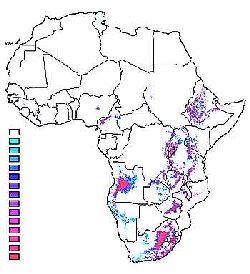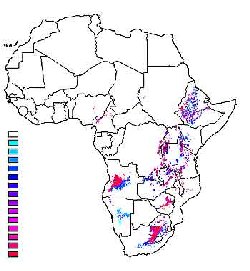|
2.4. Integrated Assessment of Potential Impacts
Work on integrated assessment of climate change in the Africa region is in
its infancy. Several different approaches are being applied in country studies
and primary research. These approaches include assessments of illustrative case
examples related to ecosystems, water supply/basin management, and socioeconomic
activities such as agriculture. These case studies begin to integrate, for specific
subregions (such as watersheds or agricultural production areas), the impacts
of climate change with the potential impacts of other factors such as land-use
change, demographic change, land degradation, air and water pollution, and economic
and social change (including factors such as changing resource demands resulting
from economic development and technological change).
The use of integrated assessment models has not been widespread in the African
context, although it is becoming an item on the agenda of several modeling groups
and organizations. More widespread use of integrated assessment models is a
priority for the IPCC in the Third Assessment Report, although it will require
fundamental advances in the research literature. As a basis for integration,
primary research on impacts on the potentially most vulnerable sectors and regions
must be conducted so that interactions among the many potential costs and benefits
can be assessed and, where possible, quantified.
2.5. Major Challenges Ahead for Africa
One of the first and most pressing scientific steps to address the shortage
of data on African climate is the maintenance and (if possible) enhancement
of the surface climate observing network. The network is important because,
for the detection of long-term climate change, stable and continuous observing
sites are necessary. The World Meteorological Organization (WMO) has a program
to designate and maintain key sites as Reference Climate Stations. This program
needs additional recognition and funding. The observing network also will help
in the calibration of new satellite-based methods of observing the climate (WMO,
1992).
There is a continual need to evaluate the results of GCM experiments that simulate
greenhouse gas- and aerosol-induced climate change to identify the likely subregional
response within Africa to projected global-mean warming. This research should
be seen as only one part of the much larger effort underway worldwide to narrow
the uncertainties surrounding predictions of greenhouse gas-induced climate
change. Determining whether recent desiccation in the Sahel is associated in
some way with global air pollution also is of great importance (Hastenrath,
1995; Ringius et al., 1996).
In addition to conducting more comprehensive assessments of the sensitivity
and vulnerability of key resource sectors and systems, there is an urgent need
to begin to apply existing and developing techniques for integration of potential
climate change impacts on several dimensions, as suggested in the introduction
to this report. These dimensions include:
- Integrating the chain of effects from changes in atmospheric composition
and climate to changes in biophysical systems to the socioeconomic consequences
(the "vertical" dimension)
- Including interactions among systems, sectors, and activities (the "horizontal"
dimension)
- Considering climate change in the context of other trends and changes in
society (the "time" or "global change" dimension)
- Considering the integrated impacts of current levels and episodes of climate
variability.
In light of the large number and magnitude of socioeconomic and environmental
changes projected for Africa, developing integrated assessments of climate change
is an urgent priority for the region.
| Box 2-10. The Potential Impact of Long-Term Climate Change on Vector-Borne
Diseases: The Case of Malaria |
|
Malaria is a vector-borne environmental disease; as such, it is greatly
influenced by macro- and microenvironmental changes. The impact of human-induced
environmental change on malaria can be graded on a scale that commences
at a global level and terminates at the level of an individual family
homestead. In the investigation of environmentally induced changes in
malaria transmission, it is impossible to restrict the study to localized
environmental changes because they are nested within the changing macroenvironment.
To understand the dynamics of these changes, as well as their interactions
and their potential for prediction of occurrence, it is essential that
we consider the role of macroenvironmental change (e.g., global warming)
as well as microenvironmental change (e.g., deforestation or changes in
land-use patterns, housing type, migration).
 |
 |
 |
 |
| Degree of Change: a) 5-month model with 1°C increase,
b) 5-month model with 0.5°C increase, c) 5-month model with 0.5°C
increase at elevation >1,300 m, and d) 5-month model with 1°C increase
at elevation >1,300 m. |
There is little doubt that global warming is now a reality (IPCC 1990,
Chapters 5, 7, 8). Over the past three decades there has been a marked
increase in mean temperatures, especially at higher latitudes; in the
tropics, the increase is estimated to be about 0.2°C (IPCC 1990, Chapter 5). Some attention has focused on global climate change and its implications
for epidemic malaria transmission (Bouma et al., 1994; Martens et al.,
1995a; Martin and Lefebvre, 1995). The impact of these climatic changes
on malaria is likely to be greatest in regions where malaria transmission
previously was limited physiologically by low temperatures, which limit
the development of the vector and the parasite. In these areas, transmission
is likely to be limited to specific seasons (when temperatures are favorable)
or may not occur at all. Increased temperatures will lengthen the transmission
season, resulting in a marked increase in incidence. Increased temperatures
also can expand transmission into regions that previously defined the
limits of malaria transmission because of the effects of latitude or elevation
(or both).
Studies in Rwanda (Loevinsohn, 1994) and Kenya (Knight and Neville, 1991;
Some, 1994) have investigated the extent to which small-scale land-use
changes can be responsible for dramatic increases in highland malaria.
The effects of short-term environmental changes, as well as changes in
human behavioral patterns (e.g., migration, changes in control activities
in adjacent regions), are superimposed on more general effects of macroenvironmental
change and are likely to play an important role in the onset of epidemics.
Thus, although climate change may mean certain regions become more susceptible
to malaria transmission, the actual risk of epidemics may remain low because
of the absence of local contributory risk factors.
The accompanying figures a, b, c, and d provide a delineation of regions
that would be environmentally affected by 0.5°C and 1.0°C increases in
temperature. Figures a and b limit the modeling process to the highland
areas of Africa, whereas Figures c and d include regions in which malaria
distribution previously was restricted by elevation and latitude. These
"new" zones of malaria transmission would be intermediate between areas
of known annual transmission and those where malaria has never occurred.
With respect to the latter (the upper limit), the simulation errs on the
side of caution: Malaria always is limited (cannot occur at present) and
is not subject to interannual variation. It uses existing long-term, retrospective,
climatological (temperature and rainfall) and topographic surfaces that
already exist for Africa (Hutchinson et al., 1995). Inherent in the prerequisite
for such epidemic fringe malaria (elevation or latitude) is that in certain
years a window of suitable environmental conditions will exist. This window
consists of a number of consecutive months with suitable environmental
conditions. The graphic provides a conservative estimate; it assumes a
prerequisite of five consecutive months, whereas in some regions (such
as the Sahel) this may be as short as three (Bagayako, pers. comm.). Despite
the occurrence of such a window, transmission may not occur. Transmission
then will be contingent on human activities that result in the introduction
of the parasite into this suitable (short-term) climatological environment.
The premise that climate variables, on their own, may not always reliably
predict epidemic risk has important implications for the forecasting of
epidemics and changes in distribution. This model is not definitive but
provides an illustration of how climate may impact upon disease distribution
and how regions of impact may be delineated. Similarly, the change or
shift in severity in existing malarial regions could be modeled. The figures
illustrate that increased temperatures would significantly increase susceptible
regions in areas of the Southern Hemisphere where distribution previously
was constrained by latitude. In contrast, northern Africa is not affected
because the distribution concurs with the Sahelian region, where the absence
of rainfall and high temperatures limits the disease (similarly with Botswana).
Conversely, in certain areas of southern Africa, especially South Africa,
low temperatures previously were limiting-thus, a significant increase
in distribution is likely.
|
As this information on sectoral vulnerabilities and integrated assessment of
potential climate change impacts is developed, it must penetrate more fully
into national government organizations and international donor agencies. This
penetration is necessary to ensure that what is known about past and present
climate variability is properly taken into account in developing national economic
and environmental plans (Sadowski et al., 1996). Such sensitization of the policymaking
process to climate variability also ensures that as knowledge about future climate
change improves, it too can be sensibly used to guide drought/climate-related
economic policy (OECD, 1996).
Within Africa, priority areas for environmental policy include securing sustainable
water supply and quality; preventing and reversing desertification; combating
coastal erosion and pollution; ensuring sustainable industrial development;
making efficient use of energy resources; maintaining forests and wildlife resources;
managing demographic change; and ensuring adequate food security. These priority
areas highlight environmental and developmental concerns in the region that
require immediate attention from the research and policy communities (Hulme,
1996a).
|